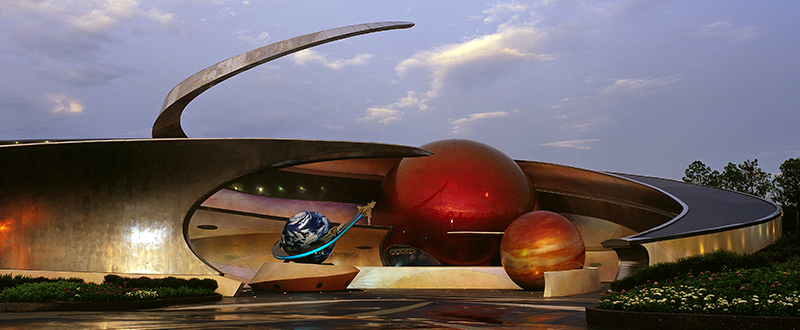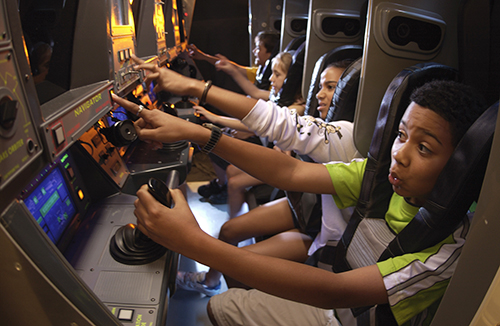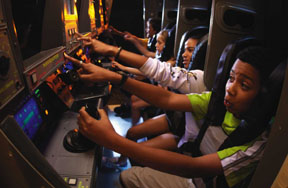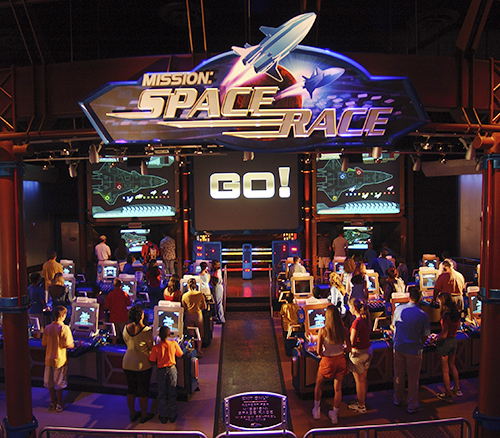
Blast-Off on Mission: SPACE
Part of NASA's mission is to inspire the next generation of explorers. NASA often reaches children—the inventors of tomorrow—through teachers, reporters, exhibit designers, and other third-party entities. Therefore, when Walt Disney Imagineering, the creative force behind the planning, design, and construction of Disney parks and resorts around the world, approached NASA with the desire to put realism into its Mission: SPACE project, the Agency was happy to offer its insight.
Mission: SPACE, the newest attraction at Walt Disney World's Epcot theme park in Orlando, Florida, features cutting-edge ride technology that gives guests the incredible sensation of lifting off and traveling through space on a mission to Mars. With input from current and former NASA advisors, astronauts, and scientists, Walt Disney Imagineering developed the attraction to be the first ride system capable of taking the adventurous straight up into simulated flight for a one-of-a-kind astronaut experience.
In 2001, Disney "Imagineers," a name coined to describe the group's unique ability to fuse imagination and engineering, sought advice from Johnson Space Center's Public Affairs Office to anchor the Mission: SPACE attraction with reality-based story elements. The office arranged a tour of Johnson's facility, giving the Imagineers a chance to experience Mission Control and the Advanced Space Suit Laboratory. Teleconferences were conducted between NASA researchers and the Imagineers to discuss the challenges of stepping beyond the lower Earth orbit.
With Mission: SPACE aiming to take guests on a virtual trip to Mars, the Imagineers also sought assistance from NASA's Jet Propulsion Laboratory (JPL) to determine what the Red Planet might look like for landing passengers. JPL provided the Imagineers with satellite imagery of Mars and its terrain. In preparing to design a spacecraft for the attraction, the Imagineers talked with NASA engineers on the future of rocket propulsion technology.
Stepping into the Mission: SPACE courtyard, Planetary Plaza, visitors are transported into the year 2036. The plaza's wall features inspirational quotations from notable figures such as President John F. Kennedy and Columbia Shuttle pioneer Kalpana Chawla. In the attraction's futuristic story line, many countries have joined together to create the International Space Training Center (ISTC), a 45,000-square-foot building featuring a curvilinear exterior that surrounds Planetary Plaza.
In the entrance of the ISTC's Astronaut Recruitment Center, guests see the motto, "We choose to go!", taken from one of President Kennedy's speeches: "We choose to go to the Moon...not because it is easy, but because it is hard." In the Recruitment Center, visitors learn about astronaut training and see a model of the ISTC's X-2 Trainer, the futuristic spacecraft they will board to embark on their mission to Mars. While the X-2 is the creation of Disney Imagineers, it is based on scientific fact and theory provided by scientists, engineers, and future-thinkers from NASA and private industry.
Inside the Space Simulation Lab, a 35-foot-tall gravity wheel slowly turns, containing exercise rooms, offices, work areas, and sleeping cubicles for space teams. Overhead, an authentic Apollo-era Lunar Rover, on loan from the Smithsonian Institution's National Air and Space Museum, is on display as a symbol of mankind's first exploration of another planetary body. A model of the ISTC's X-1 spacecraft (a precursor to the X-2) and a graphic of the X-2 with details explaining the deep space shuttle's functionality also add to the attraction.
After leaving the Space Simulation Lab, aspiring "astronauts" pass through the Training Operations Room, where several large monitors show live video feeds of ongoing ISTC training sessions. They are met by the dispatch officer in Team Dispatch, who assigns them to teams of four people before they are sent into the Ready Room. There, each person is given the role they will assume during the mission—either commander, pilot, navigator, or engineer. The guests are reminded of the importance of training and teamwork before entering the Pre-Flight Briefing. This area was inspired by the "White Room" at Kennedy Space Center, where astronauts traditionally wait to board their spacecraft.
After a final briefing, each team member enters the X-2 trainer. Mission Control monitors the launch sequence as the capsule moves into launch position, pointed straight up toward the sky. When the countdown reaches zero, the unique and exhilarating ride experience begins. Passengers experience sensations similar to what astronauts feel during liftoff, as they hear the roar of the engines and view computer-generated, photo-realistic imagery based on data taken from NASA's Mars-orbiting satellites. According to Bob Zalk, Walt Disney Imagineer and coproducer of Mission: SPACE, "For the first time, we've combined a unique aerospace technology with classic Disney storytelling, amazing guests with a realistic, one-of-a-kind spaceflight experience." During the ride, the team encounters challenges like those of an astronaut. Each team member must perform the task associated with the role he or she accepted to successfully complete the mission.
After the flight training mission, guests enter the Advanced Training Lab, an interactive play area where they can further test their skills and find out what it takes to be a part of Mission Control. In Mission: SPACE Race, up to 60 people at a time can enroll in a training adventure where two teams, each made up of both astronauts and ground control personnel, race to complete a successful mission. Teams must work together to send their rocket from Mars back to Earth. The area also offers Expedition: Mars, a simulated astronaut obstacle course with a joystick and jet-pack button to help guests explore the surface of the planet. JPL consulted on the game's imagery, creating a realistic Mars landscape.
Story Musgrave, a former NASA astronaut whose career in the Space Program spanned more than 30 years, served as an ongoing consultant on the Mission: SPACE project. According to Musgrave, Disney's new attraction is "a place where guests can imagine our future in space and their role in it, walking in the footsteps of heroes and building on the wealth of technology we've developed to date." Susan Bryan, Walt Disney Imagineer and co-producer of Mission: SPACE, states, "The realism of the experience adds to its uniqueness. Mission: SPACE is very much based in reality; it's a mix of real science and thrill." For NASA, the attraction serves as another source of inspiration for young minds, encouraging them to lead our country, and our world, into tomorrow.

Inside the X-2 capsule, four participants become a team of astronauts working together to fulfill their mission to Mars. During the adventure, which gives participants the sensation of blasting off into space, everyone participates by using joysticks and buttons while viewing outer space through individual video screens.

Inside the X-2 capsule, four participants become a team of astronauts working together to fulfill their mission to Mars. During the adventure, which gives participants the sensation of blasting off into space, everyone participates by using joysticks and buttons while viewing outer space through individual video screens.

Visitors become members of Mission Control when they engage in Space Race, a high-energy interactive game that explores the teamwork needed between Mission Control and astronauts in space missions.

Mission: SPACE at Walt Disney World Resort in Lake Buena Vista, Florida, takes guests on a pulse-racing journey to Mars.













